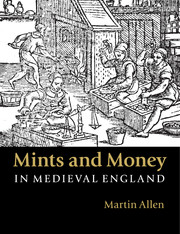Book contents
- Frontmatter
- CONTENTS
- Figures
- Maps
- Tables
- Preface
- Abbreviations
- 1 Moneyers and mints, c.973–1158
- 2 The centralisation of minting, 1158–1278
- 3 Mints and their men, 1279–1544
- 4 Mint workshop practice and equipment
- 5 Standards of weight and fineness
- 6 Profits
- 7 The exchanges in the City of London
- 8 The sources of bullion for the English coinage
- 9 Mint output
- 10 The changing size of the currency
- 11 The currency in circulation
- Conclusion
- Appendix A
- Appendix B
- Appendix C
- Appendix D
- Appendix E
- Appendix F
- References
- Index
11 - The currency in circulation
Published online by Cambridge University Press: 05 June 2012
- Frontmatter
- CONTENTS
- Figures
- Maps
- Tables
- Preface
- Abbreviations
- 1 Moneyers and mints, c.973–1158
- 2 The centralisation of minting, 1158–1278
- 3 Mints and their men, 1279–1544
- 4 Mint workshop practice and equipment
- 5 Standards of weight and fineness
- 6 Profits
- 7 The exchanges in the City of London
- 8 The sources of bullion for the English coinage
- 9 Mint output
- 10 The changing size of the currency
- 11 The currency in circulation
- Conclusion
- Appendix A
- Appendix B
- Appendix C
- Appendix D
- Appendix E
- Appendix F
- References
- Index
Summary
THE COMPOSITION OF THE ENGLISH CURRENCY FROM EDGAR TO EDWARD I, c.973–1279
The only coin usually struck by the Anglo-Saxon moneyers after the reform of Edgar was the silver penny, but there are notable exceptions to this rule in the reigns of Æthelred II (978–1016) and Edward the Confessor (1042–66), in the form of two gold pence and a unique round halfpenny. A gold penny of Æthelred II’s Helmet type (c.1003–9) from the Lewes mint was found at Hellingley, Sussex (now East Sussex), in 1808 (Fig. 11.1, top), and a gold penny from Warwick dies of Edward the Confessor’s Expanding Cross type, light issue (c.1050–1) was found during the demolition of St Clement’s Church, Worcester in about 1824 (Fig. 11.1, bottom). These coins can be identified with the mancus of 30d. mentioned in many Anglo-Saxon wills and charters, which may well have been minted in other reigns and at many other times between the reform of Edgar and the Norman Conquest. The use of such coins may have been restricted to prestigious payments such as church offerings and the major bequests and land purchases documented in the written sources.
- Type
- Chapter
- Information
- Mints and Money in Medieval England , pp. 346 - 376Publisher: Cambridge University PressPrint publication year: 2012

